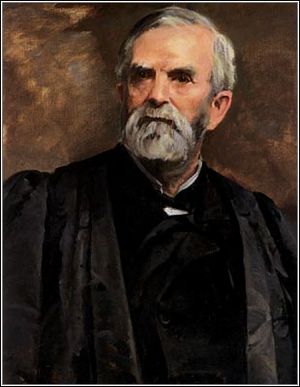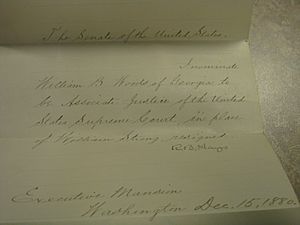William Burnham Woods facts for kids
Quick facts for kids
William Burnham Woods
|
|
|---|---|
 |
|
| Associate Justice of the Supreme Court of the United States | |
| In office January 5, 1881 – May 14, 1887 |
|
| Nominated by | Rutherford Hayes |
| Preceded by | William Strong |
| Succeeded by | Lucius Lamar |
| Judge of the United States Circuit Courts for the Fifth Circuit | |
| In office December 22, 1869 – December 21, 1880 |
|
| Nominated by | Ulysses Grant |
| Preceded by | Seat established |
| Succeeded by | Don Pardee |
| Personal details | |
| Born | August 3, 1824 Newark, Ohio, U.S. |
| Died | May 14, 1887 (aged 62) Washington, D.C., U.S. |
| Political party | Democratic (Before 1863) Republican (1863–1887) |
| Relatives | Charles R. Woods (brother) |
| Education | Yale University (BA) |
| Signature | |
| Military service | |
| Allegiance | • Union |
| Branch/service | United States Army Union Army |
| Years of service | 1862–1866 |
| Rank | |
| Commands | 76th Ohio Infantry XV Corps |
| Battles/wars | |
William Burnham Woods (born August 3, 1824 – died May 14, 1887) was an American lawyer and judge. He served as a judge in the federal court system and later as a Supreme Court Justice. Before his time as a judge, he was a politician in Ohio and a soldier in the Civil War.
Contents
Early Life and Education
William Woods was born in Newark, Ohio, on August 3, 1824. He had an older brother, Charles R. Woods, who also became a general during the Civil War. William first went to Western Reserve University in Ohio. Later, he transferred to Yale University, where he earned his degree in 1845 with honors.
Starting His Career in Law and Politics
After college, William Woods went back to Newark. He studied law by working for a well-known local lawyer named S. D. King. In 1847, he passed his exams and became a lawyer. He then joined King's law firm as a partner. They practiced law together in Newark until 1862.
Woods was a strong supporter of the Democratic Party. In 1856, he was elected as the Mayor of Newark. Two years later, in 1858, he was elected to the Ohio General Assembly, which is Ohio's state legislature. He quickly became the Speaker of the House, a very important leadership role. He also served as the leader for the minority party.
Military Service in the Civil War
Even though William Woods did not want the Civil War to happen, he believed that the Union (the North) had to win. He was against slavery, which was a main cause of the war. In 1862, he left his job in the Ohio state government to join the Union Army.
He became a lieutenant colonel in the 76th Ohio Infantry regiment. This group fought in the western part of the war. Woods fought in major battles like Shiloh and Vicksburg. He was later given the honorary rank of brigadier general.
Woods led his regiment under General William T. Sherman. He took part in the Atlanta Campaign and Sherman's famous March to the Sea. During the Carolinas Campaign, he showed great bravery at the Battle of Bentonville. For his actions, he was promoted to a full Brigadier General in early 1865. He left the Army in February 1866.
Life in the Southern States
After the war, William Woods decided to live in the South. He first lived in Mobile, Alabama, for a year and started a law practice there. Then, he moved his practice to Montgomery. In Montgomery, he bought land and grew cotton. He hired African-American workers who were now free, likely as sharecroppers. From 1868 to 1869, he worked as a Chancellor (a type of judge) in Alabama.
Serving as a Federal Judge
Judge for the Circuit Court
President Ulysses S. Grant chose William Woods to be a United States Circuit Judge. This was for the United States Circuit Court for the Fifth Circuit. He was officially nominated on December 8, 1869, for a new judge position. The United States Senate approved his nomination on December 22, 1869. He started his work as a judge that same day. He served in this role until he was appointed to the Supreme Court in 1880.
One important case Woods handled was United States v. Hall in 1871. In this case, Judge Woods supported a law called the 1870 Enforcement Act. He said that Congress could make laws to protect the basic rights listed in the Bill of Rights. This meant Congress could even make it a crime if private people violated these rights.
The Slaughter-House Cases were also very important cases that Woods judged. These cases looked at how far the 14th Amendment reached. Woods decided that a state law that created a monopoly (where only one company could do something) for slaughterhouses was against the 14th Amendment. He said the law was "void," meaning it was not valid. However, three years later, the Supreme Court disagreed with his decision.
Judge for the Supreme Court
On December 15, 1880, President Rutherford B. Hayes nominated William Woods to be an Associate Justice of the Supreme Court. He was chosen to fill the spot left by Justice William Strong. The United States Senate approved his nomination by a vote of 39 to 8 on December 21, 1880. He officially started his job on January 5, 1881.
Woods was the first person from a former Confederate state to be named to the Supreme Court since 1853. However, he was known as someone from the North, a Civil War veteran, and a member of the Republican Party. Because of this, the Republican majority in the Senate approved him.
William Woods served on the Supreme Court for six years. He passed away in Washington, D.C., on May 14, 1887. He is not seen as one of the most influential justices in the Court's history.
Legacy and Honors
During World War II, a Liberty ship was built in Brunswick, Georgia. This ship was named SS William B. Woods in his honor.
See also
- List of American Civil War generals (Union)
- Slaughter-House Cases
- List of justices of the Supreme Court of the United States


